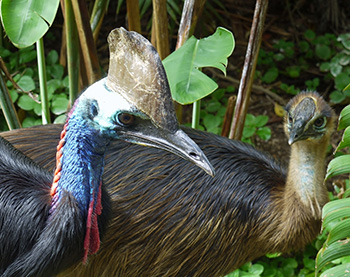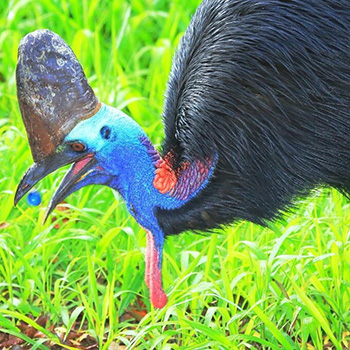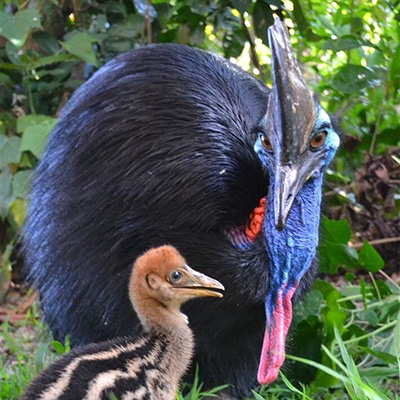Southern cassowary
Cultivating safe spaces for threatened southern cassowaries
A remarkable rainforest gardener, the southern cassowary can be dangerous if cornered, but this solitary bird still needs our help to thrive in the wild.

Fast facts
Common name: Southern cassowary
Scientific name: Casuarius casuarius johnsonii
Family: Casuariidae (emus and cassowaries)
Status: Endangered
Habitat: Dense tropical rainforests and woodlands with a high diversity of fruiting trees.
Species overview
Dubbed the world's most dangerous bird, the southern cassowary sports a vivid blue neck and long drooping red wattles. If cornered, this flightless bird can deliver a powerful kick strong enough to break bones.
The southern cassowary is a significant species to First Nations peoples. Southern cassowaries are known by many different words. For example, they are called goondoi in Djiru Country and gumbugan in Mamu Country in the Wet Tropics. On Cape York, kutini is the word used on Kuuku Ya'u Traditional Country, and on Gudang Yadhaykenu Country, it is wadthuuny.
At the time of European settlement, the southern cassowary lived in the rainforests of northeast Queensland, from north of Townsville to the tip of Cape York. Today, there are three remaining populations, one in the Wet Tropics and two in Cape York.
Outside Queensland, the southern cassowary is only found in Papua New Guinea and some surrounding islands.
On Cape York, the southern population lives in the vine forests of the McIlwraith and Iron ranges and a northern population in the less extensive vine forests north of Shelburne Bay.
In the Wet Tropics, cassowaries range from Cooktown to Paluma Range, where about 89% of their remaining essential habitat is within protected tenures. Land clearing for farming, urban settlement and other development has reduced southern cassowary habitat and numbers.
Ecology and behaviour
The southern cassowary is a rainforest gardener, spreading the seeds of rainforest trees. Some seeds are so large that no other animal can swallow and disperse them. Some rainforest seeds even need the southern cassowary digestive process to help them germinate.
Southern cassowary scats are large and often contain hundreds, if not thousands, of seeds. A ready-made fertiliser, the dung helps many plants to grow. White-tailed rats, bush rats, melomys and musky rat-kangaroos sometimes feed on seeds in southern cassowary droppings, helping further distribute the seeds.
Southern cassowaries feed mainly on fallen fruit but will also eat small dead mammals, insects, fungi, plants and snails. We have recorded over 238 species of plants in their diet, including many species poisonous to humans. Their digestive system is adapted to deal with the toxins.
The southern cassowary lives alone, inhabiting a home range or territory that changes depending on the season and food availability. The size of their range varies between 0.52km² to 2.35km². The female’s home range usually overlaps with that of several males.
The cassowary's secretive and solitary nature makes them difficult to spot. You may hear their rumbling warning calls and grunts long before you see them.
Adults generally only make contact during the breeding season from May to November. A female can mate with several males in one season. From June to October, females lay 3–5 large, olive-green eggs in a scrape lined with plant material. The males incubate the eggs for about 50 days, then guard and protect the chicks.
In contrast to their parents, young cassowaries are browner and have a duller coloured head and neck. The chicks have yellow and black stripes. Young cassowaries begin to fend for themselves from 8–18 months when their male parent chases them away. They reach maturity at about 3 years.
The purpose of the southern cassowary’s tall helmet is unknown, but it may indicate dominance and age as it continues to grow throughout life. It may also assist cassowaries in "hearing" the low vibrating sound made by other cassowaries. The helmet is spongy inside, rather than bony, and may also act as a shock absorber that protects the head when the bird pushes through dense thickets of rainforest and scrub.

Characteristics
A southern cassowary is a large, flightless bird that has:
- A height of up to 2m
- A weight of up to 76kg (females) and 55kg (males)
- A high, greyish helmet (casque)
- A vivid blue neck and long drooping red wattles
- Well-muscled legs with three toes each
- A large, dagger-shaped claw (up to 120mm long)
- Coarse, black, hair-like feathers on its body
- Wing stubs that carry a small number of long, modified quills, which curve around its body
- No tail feathers.
Threats
- Habitat loss, fragmentation and modification
- Vehicle strikes
- Introduced predators, including dogs and pigs
- Domestic dog attacks
- Climate change, especially extreme weather events like cyclones.
What’s being done?
- We have mapped the known habitat of the southern cassowary to inform conservation activities and approvals for future developments. We continue researching southern cassowaries to expand our knowledge of this species to help its conservation.
- In 2014, the CSIRO completed population surveys in cassowary habitat, estimating that up to 4,400 cassowaries lived in the Wet Tropics region. Since then, with advances in genetics, new techniques are now available. Scientists can extract DNA from faecal samples to make inferences on population dynamics.
- We are collaborating with other researchers to enhance DNA extraction capabilities for cassowary scat and feather sampling, hoping to expand on the previous population surveys.
- We are also researching other potential cassowary monitoring methods, such as satellite tracking and eDNA technology to detect cassowaries from soil and water samples.
In addition to research, we manage southern cassowaries in several ways.
- We respond to cassowary incidents and caring for sick, injured and orphaned cassowaries. We treat the birds in the wild or bring them into purpose-built facilities we manage for rehabilitation e.g. the Garners Beach Cassowary Rehabilitation Centre and the Atherton Tablelands Cassowary Facility at Lake Barrine.
- We work closely with various private sector organisations, specific veterinarians and conservation groups to provide cassowary treatment and rehabilitation.
- We provide cass-o-wary education to residents and visitors in cassowary-inhabited areas.
- We collaborate with stakeholders, researchers and other agencies to mitigate the risks to cassowaries and protect the species e.g. installing road signage for streets cassowaries frequently cross to prevent vehicle strikes.
- We maintain the Cassowary Incident Database to record incidents involving sick, injured and orphaned cassowaries. The Cassowary Recovery Team, local governments and other interested groups use this data to support conservation management and planning decisions.

Who is helping?
- The Cassowary Recovery Team
This collaborative team coordinates the implementation of the national recovery plan for the southern cassowary, aiming to maximise its long-term survival in the wild. Its members include organisations and individuals, such as representatives from many local, state and national governments, Traditional Owners, non-government organisations, community conservation groups, restoration organisations, universities, independent researchers, natural resource management organisations, and vets. - The Wet Tropics Management Authority
This authority was established in 1998 to fulfil Australia's international obligation to protect, conserve, present and rehabilitate the Wet Tropics of Queensland World Heritage Area. Its establishment has stopped the fragmentation and destruction of Wet Tropics rainforest habitat, helping to stabilise the cassowary population decades later. - Terrain NRM
This environmental management organisation delivers projects in collaboration with the community to improve rainforest habitat and connectivity in priority areas home to the southern cassowary. Working closely with the Cassowary Recovery Team, they support landholders in protecting existing habitat, planting native trees and managing invasive weeds. To attract more investment into rainforest restoration, Terrain NRM led the development of one of the first biodiversity credit schemes, Cassowary Credits. - Cassowary Coast Regional Council
The council engages with various stakeholders to support cassowary awareness, nature and biodiversity conservation, and education for residents and visitors. - Mission Beach Cassowaries Inc (MBC)
This group advocates for best-practice environmental outcomes and the southern cassowary at Mission Beach. The MBC Facebook page encourages information sharing to help raise awareness of and record cassowary behaviour and activities or potential risks, such as roads, fencing, dogs or interactions with people. - C4 Community for Coastal and Cassowary Conservation (C4)
C4 promotes habitat protection, connectivity and restoration through their environmental display centre and nursery at Mission Beach. We partner with C4 partners to operate the Garners Beach Cassowary Rehabilitation Facility, caring for injured and orphaned cassowaries.
C4 is part of the Wet Tropics Restoration Alliance and the Cassowary Recovery Team. - Rainforest Reserves Australia
We partner with this conservation group to operate the Tablelands Cassowary Rehabilitation Facility to care for injured and orphaned cassowaries. The group plants vegetation along the Toohey’s Creek wildlife corridor, promotes conservation efforts, and hosts community tree-planting days. - Cassowary Keystone Conservation
This group addressed threats to cassowaries from domestic dog attacks through legislation changes. They also developed a road location identification system to help with the rapid response to cassowary road strike incidents.
How you can help
- Never approach cassowaries or their chicks. Cassowary behaviour is unpredictable. Cassowaries can inflict serious injuries to people and pets by kicking with their large, clawed feet.
- Never feed cassowaries—it is illegal and dangerous and has caused southern cassowary deaths.
- Always discard food scraps in closed bins and ensure compost bins have secure lids.
- Always slow down when driving in southern cassowary territory.
- Never stop your vehicle to look at southern cassowaries on the side of the road.
- Keep your dogs behind fences or on a leash.
- Report cassowary sightings by calling 1300 130 372.
- If you come face-to-face with an aggressive bird, back away slowly, putting something like a tree or a backpack between yourself and the bird, and let it go on its way.